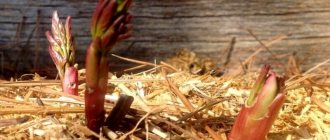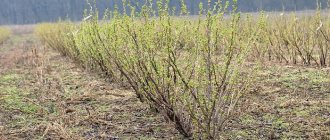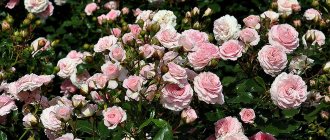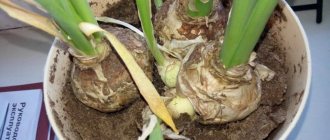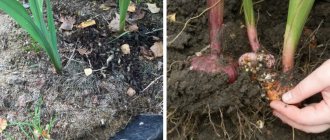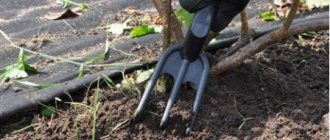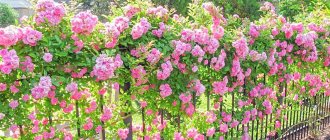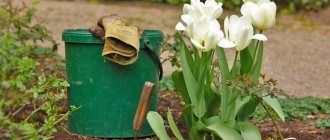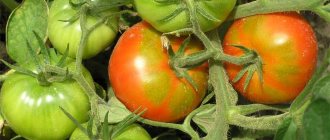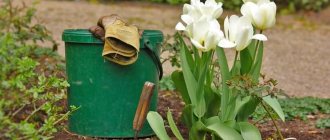Fertilizing is an important agrotechnical aspect in caring for roses. Correct and timely application of fertilizers allows you to achieve early, long and lush flowering during the season, maintain the strength of the plant and help it prepare well for the dormant period. Experts recommend feeding roses in the spring using mineral complexes and organic matter.
Ready-made complex fertilizers can be sprinkled in the root zone and then watered generously
It must be remembered that at different stages of the growing season, an excess of certain nutrients is as undesirable as their deficiency, so it is important to maintain a balance, taking into account the type of soil, its fertility, mechanical and chemical composition.
Why do you need early spring fertilizing?
With the arrival of warmer weather, the roses are freed from shelter and scheduled pruning is carried out. In spring, not only plant organisms activate their activity, but also various bacteria, insects, and their larvae found in the soil. During this period, roses need fertilizer not only to nourish and stimulate growth. Most of the mineral and organic substances included in fertilizers play the role of disinfectants that increase the immunity of plants weakened after winter.
Did you know? The essential oil extracted from rose petals is one of the most valuable in the world. To produce 1 liter of ether, you need to process 3 tons of rose petals.
You can determine which element plants lack by external signs:
- Nitrogen is responsible for the growth of green mass. The leaves are formed narrower and thinner if this element is missing. The green color is much lighter than usual. The shoots become thin and deformation often occurs. During the flowering period, dark varieties of roses have buds several shades lighter. Plants are weakened and often get sick.
- Phosphorus is responsible for the laying of buds and the development of the ground part. With its deficiency, growth retardation occurs. In the flowering phase, a lack of phosphorus can cause the buds to drop. The leaves become smaller, acquire a bluish tint on the outside, and red-brown on the inside. Leaf blades lose their shine. The shoots are deformed, many sprouts without buds are formed.
- Potassium is responsible for the formation of flower buds and the immunity of the plant body during the flowering period. With its deficiency, newly formed leaves acquire a reddish tint, old ones turn yellow, dry out and fall off. The buds are small and may not ripen at all.
- Calcium - calcium deficiency is most often observed in conjunction with potassium deficiency. When it is deficient, the shoots become deformed and the leaves become crooked. Old leaf blades turn yellow and die.
- Magnesium - the deficiency of the element becomes noticeable first of all on old sheet plates. Yellow spots are visible between the veins, the edges remain green. Most often, magnesium deficiency is associated with increased soil acidity.
- Iron - deficiency of the element is more noticeable on young leaves. Their surface acquires a yellow tint, the veins remain green. With a severe lack of iron, the leaves become white and do not stay on the shoots for long.
- Manganese - deficiency symptoms are similar to iron deficiency, but older leaf blades are primarily affected.
- Bor - the foliage is getting smaller. There is deformation and thickening of the leaf plates. The growth points of the main shoots die off, resulting in the formation of many thinned additional ones. Flowers are also formed deformed. Their petals are shortened and thickened.
- Copper - a deficiency of this element is manifested by drooping leaf plates and yellowing of their tips. The growing point dies off with the formation of a large number of thinned lateral shoots.
With a severe lack of nutrition, plants are often affected by diseases and pests and then die.
In what form to use
Manure has several degrees of decomposition. It happens:
- fresh;
- half-rotten;
- rotted;
- humus.
Fresh
The percentage of macroelements in it is high, but they are practically not absorbed by plants, since they are there in organic form. In addition, it heats up to high temperatures and can burn the roots.
Half-rotted
It is already less aggressive than fresh. The amount of macroelements in it has become less, but their digestibility has increased.
Rotten
Such manure becomes crumbly. They can be used to mulch roses.
Humus
Last degree of maturity. He's the most helpful. It is difficult to harm the plant with humus. A suitable option for fertilizing the soil and feeding rose bushes.
When to fertilize roses in spring
They begin to fertilize roses after spring pruning, when new shoots begin to grow and the leaf buds swell. They begin to apply fertilizing only from the 2nd year of the plant’s life on the site. The fertilizer application scheme is as follows:
- before the start of active growing season;
- at the bud stage;
- after each wave of flowering.
Did you know? The rose is the most sought after flower in the world. On February 14 alone, 3 million flowers are sold.
How do organic and mineral fertilizers affect plants?
Organic fertilizers consist of natural elements. These include:
- all types of manure - enrich the soil with essential microelements, have a disinfecting effect, and contain a large amount of fresh nitrogen;
- peat, silt - increase soil looseness, but are quickly depleted;
- green manure - helps enrich the soil with oxygen and nutrients; its value is equal to manure, but does not have an oxidizing effect;
- various waste of organic origin - eggshells, peelings of fruits and vegetables;
- bones, wood ash, sawdust - nourish the soil, increase looseness, have a disinfecting effect, protect against pests, and are natural deoxidizers;
- fresh or rotted greens (compost) - nutritionally equal to manure, but the microelements in the composition are presented in a more accessible form.
Organic matter contains a complex of various elements of animal and plant origin.
It is used in autumn, spring and summer in accordance with the phases of the growing season and the age of the plants. Has a long period of action. Improves soil quality. As it decomposes, it releases mineral elements. During the decomposition of organic matter, the soil is enriched with carbon dioxide, which plants need to carry out photosynthesis. Organic matter also contributes to the formation of complete soil microflora, promoting the proliferation of certain bacteria living in symbiosis with plant roots. Many elements in organic matter are in a form inaccessible to plants, and some of them, for example, nitrogen, quickly evaporate during overheating. Mineral supplements can be complex or single-component. They are created artificially.
Important! Any nitrogen-containing fertilizers (organic or mineral) are applied only in the spring at the beginning of the growing season. Later periods of nitrogen application are fraught with increased development of green mass to the detriment of flowering.
Their application makes it possible to feed plants with the component that they most need at a certain stage of the life cycle. The action of mineral fertilizers is accelerated - after application, within a day it is possible to restore the deficiency of the necessary element. Mineral fertilizing has a positive effect on the ability of plants to absorb water and vitamins from the soil, their absorption by roots and leaves.
Regarding the composition there are:
- nitrogen fertilizers - applied before the beginning of the growing season;
- phosphorus - added at the stage of bud formation;
- potash - at the stage of bud formation and throughout the entire flowering period.
The most correct option is to use mineral and organic fertilizers alternately.
Period of shoot development
The first feeding for roses is done in the spring during the period of active growth and development of shoots, from April to May. To feed roses, it is better to use ready-made nitrogen fertilizers - urea, superphosphate, ammonium and potassium nitrate, as well as organic matter.
First, use mineral fertilizers, for example, dilute a tablespoon of urea in 10 liters of water. Root watering is carried out at the rate of one liter of fertilizer for each bush. For foliar irrigation, a nutrient liquid is prepared in the following ratio - 100 g of urea plus a standard volume of water of 10 liters. The solution is used to spray 100 meters of plantings.
When using urea and superphosphate together, the latter must be neutralized using limestone or chalk in a ratio of 110 g of limestone per 1000 g of superphosphate.
After 7 days, you can fertilize with organic fertilizers.
Spring feeding of roses with mineral fertilizers
Fertilizing with minerals must be applied correctly. Exceeding the dosage or applying it in an inappropriate form leads to the death of plants or, at best, does not give any results at all. Nitrogen-containing mineral compounds applied in the spring are represented by the following fertilizers:
- urea;
- ammonium nitrate;
- calcium nitrate.
Urea
Urea or urea is a nitrogen-containing fertilizer that replaces fresh manure. Urea contains 46% nitrogen. In agriculture, grade B urea is used. Urea in urea is presented in the amide form. After entering the soil, in reaction with microorganisms living in it, the substance passes into the ammonia form, then into the nitrate form.
Did you know? The oldest rose bush in the world is 1,000 years old. It grows near the German cathedral in Hildesheim.
This sequence of microelement transformation contributes to uniform nutrition of all parts of the plant. In a reaction with oxygen without being incorporated into the soil, nitrogen from urea quickly turns into a gaseous state and disappears.
If you apply fertilizer in dry form, simply scattering it on the surface of the soil, there will be no effect. You can apply urea in the form of root and foliar (through leaves) feeding. It is also worth considering that fertilizer has an oxidizing effect, which in the future can negatively affect the condition of roses. In this regard, deoxidizers are used at the stages of its application.
It can be:
- chalk - 800 g/m²;
- wood ash - 400 g/m²;
- meat and bone meal - 300 g/m².
The above elements are added a week before using urea and a week after.
Their use cannot be combined, since nitrogen is destroyed due to the high concentration of calcium. Urea is applied at the stage of swelling of the buds after pruning, when the average daily temperature will be constantly maintained within +5...+7°C. Approximate date: start - mid-April. Root fertilizing with urea can be carried out:
- aqueous solution - used in dry weather;
- adding dry granules to the soil - used in rainy weather.
To prepare the solution, maintain the proportion of 1 tbsp.
l. urea per 10 liters of water. For better dissolution, first dilute the substance in 1-2 liters of water, and then add the rest of the liquid. Apply 1 liter per bush at the root. Before adding dry granules, you need to dig small trenches 5 cm deep around the rose bushes, at a distance of approximately 5-7 cm from the stem. Granules are placed in these trenches at the rate of 1 matchbox (13 g) of substance per 1 m2 of area. If the application of granules is carried out after rain, then the trenches need to be made deeper - 10–15 cm.
Did you know? There is a variety of Si roses with very small flowers - their size does not exceed the size of a grain of rice.
Foliar feeding is carried out if the roots are damaged, or when there is an urgent need to restore the nitrogen balance, before the beginning of June. For 1 liter of water take 4 g of the substance. The solution is mixed well and applied onto the sheet using a fine spray bottle. Manipulation is carried out only in cloudy weather, in the morning or evening.
Urea can be used as a preventative against diseases and pests. Treatment of this type is carried out in early spring, immediately after pruning, before the buds appear, with a concentrated solution, which is sprayed onto the plants themselves and applied to the soil. The solution is prepared at the rate of 60 g of urea per 10 liters of water. With this type of treatment, fertilizing with urea is not carried out.
Ammonium nitrate
This fertilizer contains 34% nitrogen. Ammonium nitrate is used from the beginning of the growing season until the end of June. It is rarely used on its own - phosphorus and potassium elements are added to the ammonium nitrate solution, which allows the plants to be provided with adequate nutrition. Apply the solution under the root. It is prepared at the rate of 1 tbsp. l. saltpeter per 7 liters of water + 20 g of superphosphate + 3 tbsp. l. wood ash. This composition is enough to fertilize 1 rose bush.
Important! Ammonium nitrate is applied only at the root. Not suitable as foliar feeding.
A similar composition is applied 20 days after the first feeding. The last time the solution is applied is in late autumn, before covering the bushes - during this period, nitrogen is no longer absorbed by the roots. In the spring, with active snow melting, the roots will quickly begin to absorb moisture along with the nitrogen remaining in the soil, which will contribute to the healing and rapid awakening of the buds.
Calcium nitrate
The fertilizer contains 13% nitrogen and 19% calcium. The advantage of this fertilizer is the possibility of its use at almost all stages of the growing season of roses, due to the fact that the soil does not oxidize, as happens when using the 2 nitrogen-containing compounds described above. Calcium promotes the rapid absorption of nitrogen by all parts of the plant. Suitable for use even on acidic soils. Calcium nitrate is applied as the first root dressing after pruning rose bushes.
The second time it is applied in the same way after 10 days. For irrigation, add 4 g of the substance to 1 liter of water - this will be enough for one bush. Subsequently, a composition of 2 g per 1 liter of water is used for foliar feeding. Fertilizing helps to form full-fledged greenery, plays a role in the formation of buds, and also helps protect plants from various types of rot and pests. Fertilizer can be used before planting roses.
Important! Calcium nitrate is compatible with any fertilizer except simple superphosphate.
Humates
Humates are a new class of agrochemicals. Research on this topic has not yet been completed.
Humates are sodium and potassium salts of humic acids. Humic acids were first discovered in soil humus. Humus is formed when soil organic matter is decomposed by soil microbes.
Humates can be industrial or natural. In plant growing, only natural ones, obtained from natural organic deposits, are used. Externally, they differ from industrial ones.
Ballastless natural humates are wet, lumpy, black or brown. They are used as growth stimulants and general strengthening agents for roses and other plants.
Ballast humates are commercially available. They are granules of complex fertilizers coated with a humate coating. On the packaging of such drugs they write “Gumate NPK”. It is good to use after pruning roses.
Potassium humate
Potassium humate is chemically neutral. Its pH is 7−8. Therefore, it can be safely used on different soils. It can be used effectively when processing rose cuttings for rooting; their survival rate becomes much higher. Humates enriched with microelements are sold. On such packages there is an inscription - “Potassium humate +7”.
Sodium humate
It is not advisable to use this preparation on alkaline soils, since its pH is almost 10. But it is more effective than potassium humate in cases where it is necessary:
- protect the plant from pests;
- help him survive the drought;
- increase resistance to freezing;
- reduce leaf and bud fall.
What is the difference
There is no big difference in the effect of these drugs on plants. They are interchangeable. You just need to take into account the nature of the soil in your garden plot. If it is alkaline, then it is better to use potassium humate.
Humates should not be used together with phosphate fertilizers and calcium nitrate. In this case, insoluble compounds are formed. It is necessary to carry out separate feeding. First, humates are added to the moist soil, and after five days the necessary fertilizer is applied.
Organic fertilizers for roses
At the initial phase of the growing season, various types of manure can be used instead of mineral nitrogen-containing fertilizers. Chicken and cow have the advantage. They should be applied only in diluted or rotted form.
Chicken droppings
Chicken manure used:
- after pruning in spring;
- in the case of a long spring in mid-May;
- at the beginning of the budding phase;
- after the first wave of flowering.
Dried chicken manure is used to prepare a liquid concentrate. For 10 kg of litter add 20 liters of water. This composition is infused for 2 weeks in a closed container. After infusion, the concentrate is mixed with water 1:1 and used for watering plants at the rate of 10 l/m². For emergency replenishment, add a handful of dry litter or granules to 10 liters of water.
Stir the solution for 30 minutes, achieving maximum dissolution. Apply immediately after preparation at a rate of 10 l/m². Dung that has rotted along with the litter can be used to incorporate it into the soil in early spring, immediately after pruning the bushes. The droppings are placed in a thin layer in a circle near the trunk. Then water abundantly and mulch the soil with peat.
Cow infusion
Mullein is used as root and foliar feeding only in the spring and until the beginning of flowering. The mullein must first be prepared and infused. For 1 kg of manure add 5 liters of water. For manure that has rotted along with the bedding, 3 liters of water will be enough. The solution is infused for a week, stirring daily. The concentrate is diluted with water 1:3 before application.
Did you know? The trunk of the largest rose bush in the world reaches 2 m in diameter. It grows in Arizona and covers an 8 m² gazebo area with its shoots strewn with flowers.
For root feeding, the consumption is 3 l/m². After watering, the tree trunk circle must be mulched. For foliar feeding, the concentrate is diluted 1:5, be sure to filter it first. Spray from a fine spray bottle only in cloudy weather in the evening or morning, on the inside of the leaf blades.
Fertilizers with folk remedies
Recently, banana peels have been a popular supplement. It enriches the soil with potassium, calcium, magnesium and iron - these components have a beneficial effect on the formation of buds and help increase plant immunity. It is used in powder form during the budding phase. To do this, the crushed peel is dried in the oven at +100°C and then ground into powder. Place 1 tbsp into the tree trunk circle. l. powder for each plant.
Onion peel enriches the soil with vitamins and has a disinfecting effect, which makes it possible to use infusions with it at any phase of the growing season, as well as to combat aphids and fungal diseases. Add 2 cups of tightly packed husks to 10 liters of water. The water is brought to a boil and immediately turned off, then the broth is infused for 2 hours. Used for watering and spraying plants from the beginning of summer every 10 days.
To reduce acidity and enrich the soil with calcium, eggshells are used. Fertilizing can be applied before and after application of nitrogen-containing compounds. The eggshells are dried in an oven at +100°C and then ground into powder. Store in a cool, dry place. Add 1 tbsp. l. powder under the bush.
Watering and spraying with yeast solution can improve the condition of the soil, increase the absorption of nutrients by roots and leaves, and also extend the flowering phase. They are used at all stages of the growing season, starting from the budding period. To 1 liter of warm (+30°C) water add a pack of dry yeast (10 g) + 1 tbsp. l. Sahara. The solution is allowed to ferment. Then they decant and water or spray on the inner surface of the leaf. Can be used every 2 weeks.
From May to June, herbal formulations can be used. To do this, take 10 liters of water for 8 kg of grass (nettle, alfalfa, dandelion and other greens), crushed together with roots. To this mixture add half a loaf of stale rye bread and 2-3 tbsp. l. Sahara. The raw materials are placed under pressure and covered with a lid. Keep it for a week. For root feeding, the concentrate is diluted with water 1:10, for foliar feeding - 1:20. For each bush, 1 liter of working solution is used. The interval between feedings of this type is 2 weeks.
Ash from plant residues is very beneficial for the plant organism as a whole. It is used at all stages of the growing season. To eliminate the influence of the ash composition on the acidity of the soil, use a solution: add 400 g per 10 liters of water for root feeding, 200 g for foliar feeding. The diluted mixture is infused for a week, then decanted. Apply 1 liter per plant. Can be used every 20 days.
Fertilizing roses with ready-made complex fertilizers
One of the cheap options for ready-made universal complex fertilizer is nitroammophoska. It contains 3 main elements necessary for plant development (nitrogen, potassium, phosphorus) + additional microelements in smaller quantities. It is used from April, after removing coverings and pruning rose bushes, until the beginning of June.
Fertilizer is applied in dry form to a depth of 3–5 cm, a handful for small bushes and 0.5 cups for large ones. Nitroammophoska can also be used in the form of an aqueous solution: 20–30 g of substance per 10 liters of water. In June, the soil is mulched with any organic matter with the addition of nitroammophoska in the same amount. Flowering plants are given foliar feeding in July with a 1% solution of nitroammophoska.
Find out what and how to fertilize roses correctly.
"Biocin" is a special complex fertilizer intended for roses. It contains not only all the necessary microelements, but also an immune stimulant. After wintering, the drug is used for watering. Manipulations are carried out 3 times at intervals of a week. Dosage: 0.5–1 cap per 5 liters of water; This amount is enough to water 1-2 bushes. Throughout the entire growing season, leaf spraying is carried out 1-2 times a month: add 1-2 caps of the drug to 5 liters of water.
When applying fertilizer to rose bushes, the most important thing is to follow the correct dosage. By adhering to the feeding regime, taking into account the phases of plant vegetation, you can not only improve their quality indicators, but also completely protect the site from the spread of diseases and pests.
Is it even possible to do this?
Some inexperienced gardeners leave negative reviews about the use of urea for roses. And as a result, it turns out that they, knowing that nitrogen helps the rose bush grow green mass and strengthen the shoots, add it in too large quantities.
Others pay attention to the fact that fertilizer was applied, but no effect occurred. It turns out that they simply sprinkled granules on dry soil under a bush. There is no rain, but they are “waiting by the sea for weather.” Then they are offended that the money was wasted.
Still others, trying to fight pests by spraying the leaves with a urea solution, burn the leaves. That is, again the dosage is violated. Or they feed it at the wrong phase of plant development. The result is a leafy bush with small, sparse flowers.
Eliminate these errors. Follow the dosage and use it correctly. And then the rose bush will delight you with abundant and lush flowering.
